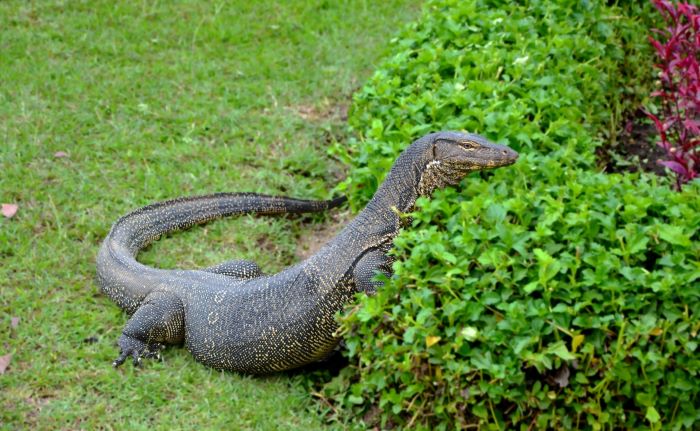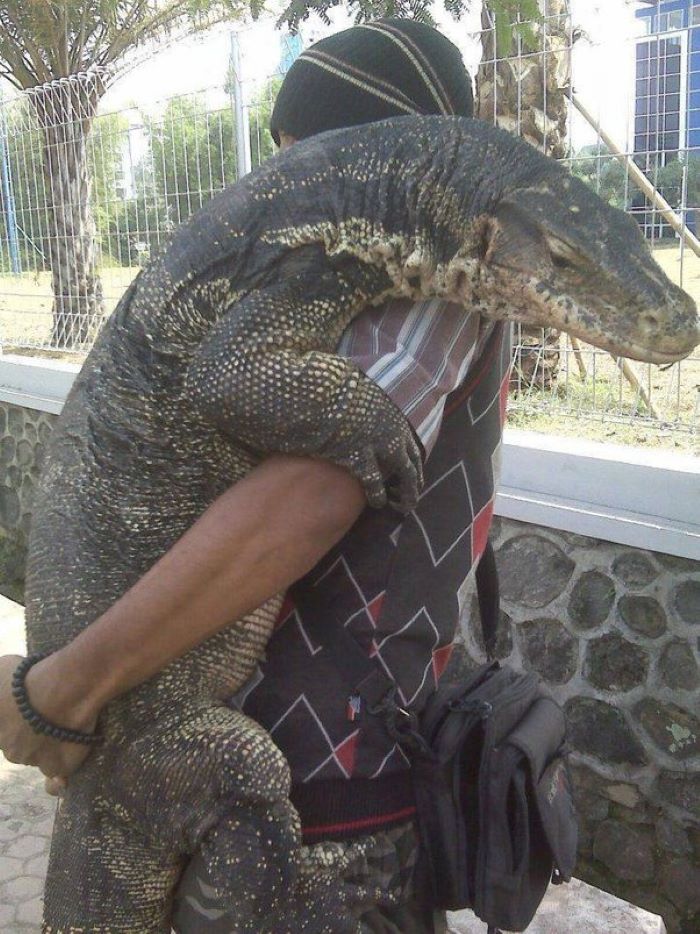The Varanus komodoensis, Komodo dragon, or monitor, is the heaviest and largest lizard globally. It belongs to the family Varanidae, i.e., the monitor family, and gets its name from one of its habitats, the Komodo Island. Locals often refer to this lizard as ‘biawak raksasa’ (giant monitor), ‘ora,’ or ‘buaya darat’ (land crocodile).
Finally, while there are over 3000 different species of lizards, the Komodo lizard is just a single species that may have some color variations.
Is Komodo Dragon a Good Pet?

In general wild animals do not make good pets, but in this case, having a Komodo Dragon as a pet may rank right up there with having a hippo as a pet. Komodos have bad dental hygiene, to the point that they’re poisonous. Scientists have identified some 50 different bacterial strainsin their saliva, at least seven of which are highly toxic. If the komodo’s bite doesn’t kill you, its deadly drool likely will.
Their table manners leave a bit to be desired. The muscles of the Komodo’s jaws and throat allow it to open incredibly wide and swallow huge chunks of meat with astonishing speed. An adult Komodo can eat up to 80 percent of its own body weight in a single meal. Komodos are cannibals. Large ones will eat smaller ones. Young Komodos are known to roll in excrement so that they won’t be eaten by other dragons.
The Komodo is not “safe” around any other animal. Anything its size or smaller, it will try to kill and eat. And it never stops growing. So once it gets to be the size of your neighbor’s toddler, the kid moves into “prey” territory.
Are Komodo Dragons Friendly to Humans?
The diet of Komodo dragons mainly consists of Javan Rusa (Rusa timorensis), though they also eat considerable amounts of carrion. Komodo dragons also occasionally attack humans. Komodo dragons were first recorded by Western scientists in 1910. Their large size and fearsome reputation make them popular zoo exhibits.
How much does it Cost to Buy a Komodo Dragon?
According to wildlife officials in the United States, komodo dragons are being sold on the black market. In a report by CBS News, when smugglers offer a komodo dragon for sale, the price to buy the animal is reported to be $30,000. Buyers can also purchase a Madagascar tortoise for $30,000 as well.
What do I Feed My Pet Komodo Dragon?
Komodo dragons are never kept as pets because they are an endangered species. Komodo dragons are carnivores, so a whole animal diet is best. You can maintain them on a diet similar to that of other giant monitor lizards – whole frozen/thawed rodents and rabbits.
Zoos typically feed them a mix of different frozen/thawed prey animals, beef shank, and commercial reptile diets of some sort. Eggs and fish can be given occasionally as treats. At the same time, rodents are the primary part of the diet. Whole poultry works, too. Their protein ratio to greens, vegetables, and fruits should be 75/25. They should be fed 75% insects and 25% plant material.
For the first two months, bearded dragons will need to be fed crickets throughout the day.
Are Komodo Dragons Cannibals?
Not only are they cannibalistic, but Komodos are known for eating their own offspring. After the eggs hatch, baby Komodos instinctively climb high up in any trees to avoid being eaten by their mothers or other nearby Komodos. They can remain up in the trees until they are four years old when they return to the ground and can then live up to 30 years old.
Can Komodo Dragons Hurt You?
Even though a Komodo dragon attack is rare, it can kill a human. Komodo dragons have serrated teeth that can hinder even humans. Their venom is powerful and can kill a human within hours of a bite. Their physical strength is also overwhelming for humans. The Komodo dragon saliva contains multiple strains of bacteria that are also extremely harmful to humans.
How Long do Komodo Dragons Live?
Komodo dragons live about 30 years in the wild, but scientists are still studying this.
Can Komodo Dragons Climb Stairs?
Komodo dragons don’t climb stairs; they find it very difficult. Unfortunately, even though the Komodo dragon looks slow and somewhat lazy, they are fast runners and can quickly reach a pace of 18 kilometers per hour.
If you see a (traditionally wooden) stilted house, immediately climb up the stairs because the komodo cannot do that.
How Smart are Komodo Dragons?
Komodos are brilliant among reptiles. Wild Komodos hunting techniques involve a lot of decision-making and patience. They are indicative of a certain level of intelligence. Zoo-raised Komodos have shown the capacity to remember specific individuals (those who bring them food at least). Their handlers generally do not have to worry about being attacked and eaten as the Komodos behave themselves to the person bringing them food regularly.
They are not dumb but calling them ‘intelligent’ is a bit of a stretch when we compare them to intelligent creatures such as dogs, apes, or dolphins. But they are not mindless instinct-driven reptiles like we normally think of in regards to snakes or other lizards. They are smart enough to be patient, wait for opportunities, recognize friend from foe rather than prey or predator, make decisions, etc.
Can Komodo Dragons Swim?
Komodo dragons are known as talented swimmers! These reptiles will travel from one island to another by swimming. Komodo dragons have been known to be able to swim up to 1,000 feet at a time! They may also swim in order to escape from other Komodo dragons and they can dive and swim underwater as well, which helps them elude their predators.
But when the dragons found themselves separated from their home island by a thin stretch of ocean, only a quick swim away, they settled in. The water itself isn’t the problem, since Komodo dragons can swim pretty well.
Do Komodo Dragons Live by a Lot of Water?
Komodo dragons can only be found on five different islands in southeastern Indonesia. They can be found on the islands of Komodo, Rinca, Gili Montana, Gili Dasami, and Flores. This is the perfect place for these reptiles to live because they enjoy hot, humid weather, and these islands often reach a temperature of 95 degrees Fahrenheit during the day with up to 70% humidity.
Since these creatures live on islands, they are surrounded by water!
None of these islands are that big – for example, the island of Komodo is about 150 square miles, making it smaller than the total square mileage of New York City! Gili Montang is even smaller – this island has a total landmass of only 12 square miles. These islands are not all water though! All of these islands were made from volcanoes and they are covered in rocky hills, forests, and grasslands.
Are Komodo Dragons actually Dragons?
They are not dragons, but they are giant lizards globally! These lizards can grow up to ten feet long, about as long as a small car. On average, these lizards weigh about 150 pounds, but the enormous Komodo dragon weighed nearly 300 pounds! That is one giant lizard.
The reason they are called “dragons” is that there were rumors that there was a dragon-like creature on the island of Komodo. No Western scientist had laid eyes on a komodo dragon until 1912. Since the largest amount of these lizards can be found on the island of Komodo, they were given the name of the island.
Do Komodo Dragons Move Fast?
They may look large and lumbering, but these lizards are all muscle and can move with explosive speed. A Komodo dragon can run at an impressive 12 miles per hour (19 kph) in an all-out sprint. The average human sprints at 15 miles per hour (24 kph).
So, if you are caught by surprise by a charging Komodo dragon that was lying in wait for a meal, run like your life depends on it. Komodo dragons have been responsible for the death of four people in the last 41 years. Don’t underestimate their speed just because of their bulk.
Do Komodo Dragons have Tongues?
Their sense of smell is their primary food detector, however. According to the Smithsonian Zoo, Komodo dragons, like snakes, use their forked tongues to sample the air and then touch the tongue to the roof of their mouth, where particular organs analyze the airborne molecules.
If the left tongue tip has a more concentrated “smell,” the dragon knows that their prey is approaching from the left.
What is the Diet of Komodo Dragons?
Komodo dragons are carnivores, meaning they eat meat. They are such fierce hunters they can eat colossal prey, such as large water buffalo, deer, carrion, pigs, and even humans. They will also eat smaller dragons. They can eat 80 percent of their body weight in one feeding, according to National Geographic.
The Komodo has a unique way of killing its prey. First, it springs up and knocks the prey over with its huge feet. Then they use their sharp, serrated teeth — which are a lot like a shark’s — to shred their prey to death. If the prey escapes, it will die within 24 hours of blood poisoning because the Komodo’s saliva contains 50 strains of bacteria, according to National Geographic. With its fantastic sense of smell, the Komodo will find the dead animal and finish its meal.
Are Komodo Dragons Cold-Blooded?
Komodo dragons are cold-blood rather than warm-blooded. This means that they depend on environmental heat sources to warm their bodies. The researchers discovered genetic adaptations involving the function of the mitochondria, the power generators of cells that are critical in governing the function of cardiac and other muscles, that may amplify the lizard’s aerobic capacity.
As cold-blooded creatures, reptiles typically lack aerobic capacity, rapidly becoming exhausted after physical exertions, unlike warm-blooded mammals. Komodo dragons, an exception among reptiles, can achieve near-mammalian metabolism. The researchers also found adaptations involving genes that control chemical sensors involved in an advanced sensory system that lets Komodo dragons detect hormones, the body’s chemical messengers, and pheromones, chemicals released particularly by mammals that serve as cues to other members of their species.
How do Komodo Dragons Protect themselves?
They will use their tails as a weapon to protect themselves and catch prey. The tail of the Komodo is so strong it can knock down large wild boars and deers! They will also swing their tails to scare off other dragons or animals if they feel in danger. Komodo dragons have several vital adaptations, including long and sharp claws, sharp teeth and strong jaws, potent venom, and the ability to run at high speeds.
Komodo dragons can grow to be quite large, but despite their size, they rely on several physical characteristics to help them survive. They live on the Lesser Sunda Islands of Indonesia, and they are the top predators in their native range.
Komodo dragons are among the few hardy organisms that survive well in the harsh climate of the Sunda Islands. These dragons are giant lizards globally; according to National Geographic, adults may reach lengths exceeding 10 feet from head to tail and weigh over 300 pounds. They look as formidable as they act, with long, flat heads, rounded snouts, scaly skin, bowed legs, and long, muscular tails. Komodo dragons have carnivorous diets and eat a wide variety of prey, including deer, pigs, water buffalo, and other Komodo dragons.
These reptiles put their strong claws, teeth, and jaws to use when hunting and feeding. They may reach speeds of up to 15 miles per hour, and knockdown full-grown deer and pigs. After attacking, dragons stun their prey using powerful venom and use their strong claws to tear through tough, thick hides.

Dr. Ananya Singh, the expert behind ThePetster.com, is a dedicated veterinarian with over 9 years of experience in animal health and welfare. She holds a Doctor of Veterinary Medicine (DVM) degree. Dr. Singh specializes in comprehensive pet care, preventative health, and holistic wellness. Follow her on Instagram for expert advice and updates.
